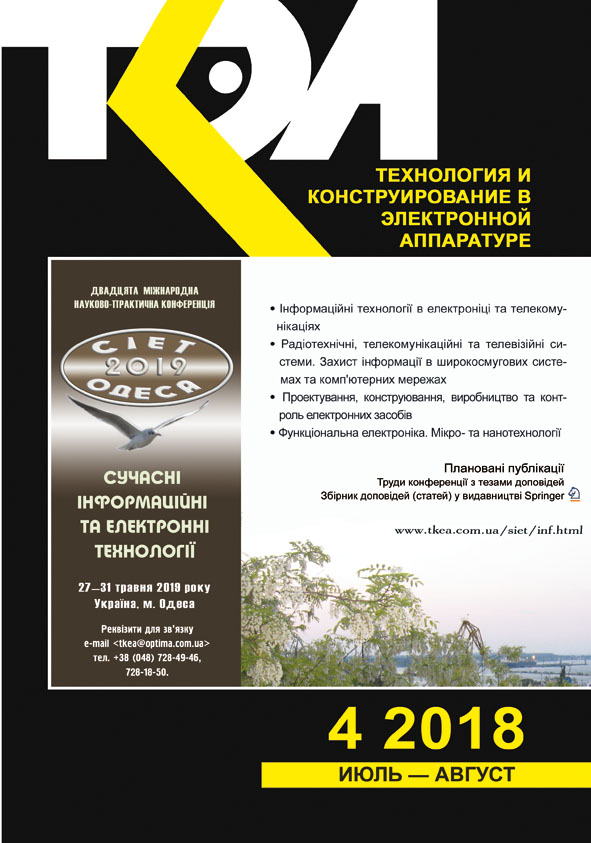Electrophysical and photoelectric characteristics of a three-barrier photodiode GaAs structure
Abstract
The work is devoted to the study of physical features of electronic processes taking place in the space charge region and in the base region of arsenide-gallium three-barrier photodiode structures with the effect of locking two adjacent transitions. The structures have high photosensitivity in the «impurity» region of the spectrum at both inclusion polarities. The obtained results suggest that such structures can be used in optical communication systems. The study allowed showing that a three-barrier photodiode m1—p-GaAs—n-GaAs—m2-structure with a high quantum efficiency can exceed 8 times the photosensitivity of a photodiode as compared to a photodiode with a single p–n junction. In the m1—p-GaAs—n-GaAs—m2 photodiode structure, the maximum photosensitivity is achieved in the impurity region of the spectrum (above 1.0 μm) when excitation of nonequilibrium current carriers through the barrier to the semiconductor, in contrast to the intrinsic spectral region (0.86 μm). It has been shown experimentally that the photosensitivity of the structure in the direct-displacement mode of the p–n junction is larger, compared with the locking mode, and the maximum photosensitivity is achieved in the impurity region of the spectrum. That is, the impurity levels of oxygen present in the base region take part in the separation of the photocarriers. The dependence of the current on the voltage is described by a power function with an exponent of 0.5 corresponding to the generation-recombination process in the space-charge region of the p–n junction.
References
Abdulkhayev O.A., Yodgorova D.M., Karimov A.V., Kuliyev Sh.M. [High-sensitivity photodetector based on a germanium double-barrier structure with a closing effect]. Tekhnologiya i konstruirovaniye v elektronnoy apparature. 2015, no 4, pp. 24-27.
Ambrozyak А. Konstruktsiya i tekhnologiya poluprovodnikovykh fotoelektricheskikh priborov [The design and technology of semiconductor photovoltaic devices]. Мoskow, Sov. Radio, 1970, 392 p. (Rus)
Batavin V.V. Kontrol’ parametrov poluprovodnikovykh materialov i epitaksial’nykh sloyev [Control parameters of semiconductor materials and epitaxial layers]. Мoskow, Sov. Radio, 1976, 102 p. (Rus)
Vartanyan S.P. Optoelektronnyye pribory i ustroystva v poligrafii. Glava 2. Elementnaya baza optoelektronnykh priborov i ustroystv [Optoelectronic devices and devices in printing]. Мoskow, Publishing house MSUP, 2000, 187 p. (http://hi-edu.ru/e-books/xbook138/01/part-003.htm) (Rus)
Dobrovolskiy Yu. G., Ashcheulov A. A. Silicic p–i–n-photodiode with small dark current. Tekhnologiya i Konstruirovanie v Elektronnoi Apparature, 2011, no. 3, pp. 27-31. (Rus)
Andreev I.A., Serebrennikova O.Y., Sokolovskii G.S. et al. Semiconductors, 2013, vol. 47, iss. 8, pp. 1103-1109. https://doi.org/10.1134/S1063782613080046
Joe C. Campbell. Recent advances in telecommunications avalanche photodiodes. Journal of Light Wave
Technology, 2007, vol. 25, iss. 1, pp. 109-121. https://doi.org/10.1109/JLT.2006.888481
Ushakov N.М., Solotsky А.N., Vedus V.E., Petrosyan V.I. [Inner photo intensification in planar structures with a Bardeen barrier on GaAs.] Pisma v ZhTPh, 1990, vol. 16, iss. 1, pp.17-21. (Rus)
Grigoryan G. E., Pogosyan L. N., Khudaverdyan S. Kh. The creation and investigation of photoelectric features of the double-barrier structures with narrow recrystallized base. Materials of the Conf. on Optoelectronic and Microelectronic Materials and Devices DEEE. The University of Western Australia, 1998, рр. 242-244.
Chu J. L., Sze S.M. Microwave Oscillation in pnp Reach-Through BARITT Diodes. Solid-State Electronics, 1973, Vol.16, pp. 85. https://doi.org/10.1016/0038- 1101(73)90128-7
Copyright (c) 2018 Abdulkhaev O. A., Yodgorova D. M., Karimov A. V., Yakubov A. A., Kuliyev Sh. M.

This work is licensed under a Creative Commons Attribution 4.0 International License.

